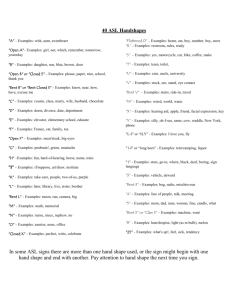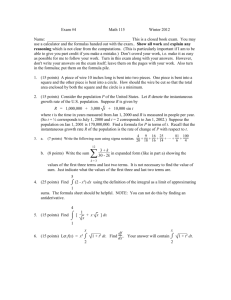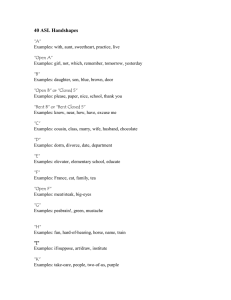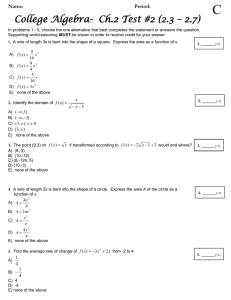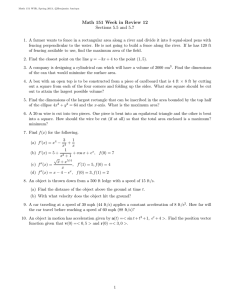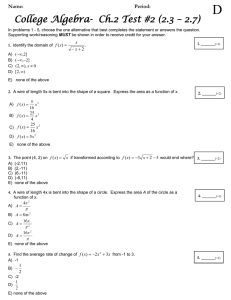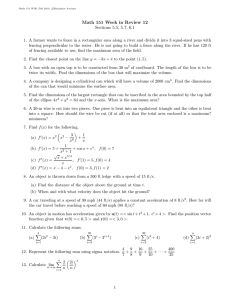p functions Yeow Meng Chee · Yin Tan · Xian De Zhang
advertisement
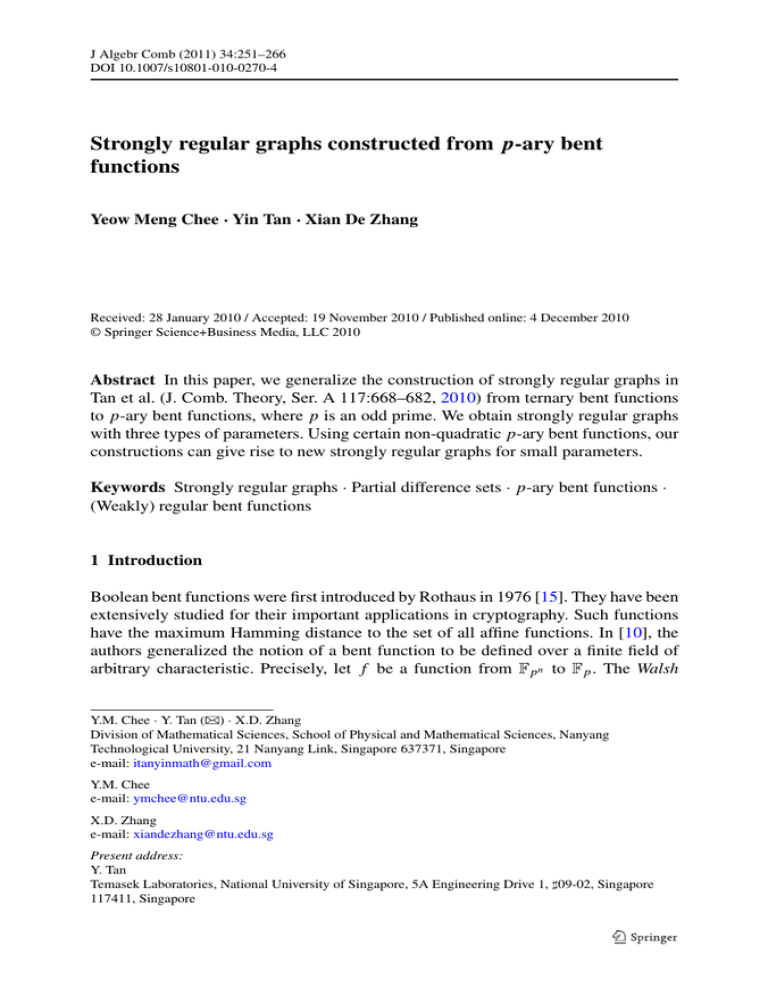
J Algebr Comb (2011) 34:251–266
DOI 10.1007/s10801-010-0270-4
Strongly regular graphs constructed from p-ary bent
functions
Yeow Meng Chee · Yin Tan · Xian De Zhang
Received: 28 January 2010 / Accepted: 19 November 2010 / Published online: 4 December 2010
© Springer Science+Business Media, LLC 2010
Abstract In this paper, we generalize the construction of strongly regular graphs in
Tan et al. (J. Comb. Theory, Ser. A 117:668–682, 2010) from ternary bent functions
to p-ary bent functions, where p is an odd prime. We obtain strongly regular graphs
with three types of parameters. Using certain non-quadratic p-ary bent functions, our
constructions can give rise to new strongly regular graphs for small parameters.
Keywords Strongly regular graphs · Partial difference sets · p-ary bent functions ·
(Weakly) regular bent functions
1 Introduction
Boolean bent functions were first introduced by Rothaus in 1976 [15]. They have been
extensively studied for their important applications in cryptography. Such functions
have the maximum Hamming distance to the set of all affine functions. In [10], the
authors generalized the notion of a bent function to be defined over a finite field of
arbitrary characteristic. Precisely, let f be a function from Fpn to Fp . The Walsh
Y.M. Chee · Y. Tan () · X.D. Zhang
Division of Mathematical Sciences, School of Physical and Mathematical Sciences, Nanyang
Technological University, 21 Nanyang Link, Singapore 637371, Singapore
e-mail: itanyinmath@gmail.com
Y.M. Chee
e-mail: ymchee@ntu.edu.sg
X.D. Zhang
e-mail: xiandezhang@ntu.edu.sg
Present address:
Y. Tan
Temasek Laboratories, National University of Singapore, 5A Engineering Drive 1, 09-02, Singapore
117411, Singapore
252
J Algebr Comb (2011) 34:251–266
transform of f is the complex valued function Wf : Fpn → C defined by
Wf (b) :=
f (x)+Tr(bx)
ζp
,
b ∈ Fpn ,
x∈Fpn
where ζp is a primitive pth root of unity and Tr(x) is the absolute trace function,
pi
i.e., Tr(x) := n−1
i=0 x . The function f is called p-ary bent if every Walsh coefficient Wf (b) has magnitude p n/2 , i.e., |Wf (b)| = p n/2 for all b ∈ Fpn . Moreover, f is called regular if there exists some function f ∗ : Fpn → Fp such that
f ∗ (b)
f ∗ (b)
Wf (b) = p n/2 ζp
, and f is called weakly regular if Wf (b) = μp n/2 ζp
for
some constant μ ∈ C with |μ| = 1. Obviously, regularity implies weak regularity.
It is shown in [7, 9] that quadratic bent functions and most monomial p-ary bent
functions are weakly regular, except for one sporadic non-weakly regular example.
Recently, a new family of non-quadratic weakly regular p-ary bent functions has been
constructed in [8] and a new sporadic non-weakly regular bent function was given.
However, there are still few non-quadratic bent functions known over the field Fpn
when p ≥ 5.
There are many motivations to find more weakly regular bent functions, especially
non-quadratic ones. Recently, it is shown in [14, 16] that, under some conditions,
weakly regular bent functions can be used to construct certain combinatorial objects,
such as strongly regular graphs and association schemes. Precisely, let f : F32k → F3
be a weakly regular bent function. Define
Di := x : x ∈ F32k f (x) = i ,
0 ≤ i ≤ 2.
It is shown in [16] that D0 , D1 , D2 are all regular partial difference sets. The Cayley graphs generated by D0 , D1 , D2 in the additive group of F32k are strongly regular graphs. Some non-quadratic bent functions seem to give rise to new families of
strongly regular graphs up to isomorphism (see [16, Tables 2, 3]).
In this paper, we generalize the work in [16] by using p-ary bent functions to construct strongly regular graphs. We show that if f : Fp2k → Fp satisfies Condition A
(defined in Sect. 3), then the subsets
D = x ∈ F∗p2k f (x) = 0 ,
DS = x ∈ F∗p2k f (x) is a non-zero square ,
DS = x ∈ F∗p2k f (x) is a square , and
DN = x ∈ F∗p2k f (x) is a non-square
(1)
are regular partial difference sets. Using this construction, it seems that the p-ary
bent functions in [8] may give rise to new negative Latin square type strongly regular
graphs. For small parameters, we have verified that the graphs are new.
The paper is organized as follows. In Sect. 2, we give necessary definitions and results. The constructions of strongly regular graphs will be given in Sect. 3. In Sect. 4,
we discuss the newness of the graphs obtained.
J Algebr Comb (2011) 34:251–266
253
2 Preliminaries
Group rings and character theory are useful tools to study difference sets. We refer
to [13] for the basic facts of group rings and [11] for the character theory on finite
fields.
Let G be a multiplicative group of order v. A k-subset D of G is a (v, k, λ, μ)
partial difference set (PDS) if each non-identity element in D can be represented as
gh−1 (g, h ∈ D, g = h) in exactly λ ways, and each non-identity element in G\D
can be represented as gh−1 (g, h ∈ D, g = h) in exactly μ ways. We shall always
assume that the identity element 1G of G is not contained in D. Using the group ring
language, a k-subset D of G with 1G ∈ D is a (v, k, λ, μ)-PDS if and only if the
following equation holds:
DD (−1) = (k − μ)1G + (λ − μ)D + μG.
(2)
Combinatorial objects associated with partial difference sets are strongly regular
graphs. A graph Γ with v vertices is called a (v, k, λ, μ) strongly regular graph
(SRG) if each vertex is adjacent to exactly k other vertices, any two adjacent vertices
have exactly λ common neighbors, and any two non-adjacent vertices have exactly μ
common neighbors.
Given a group G of order v and a k-subset D of G with 1G ∈ D and D (−1) = D,
the graph Γ = (V, E) defined as follows is called the Cayley graph generated by D
in G:
1. The vertex set V is G.
2. Two vertices g, h are joined by an edge if and only if gh−1 ∈ D.
The following result points out the relationship between SRGs and PDSs.
Result 1 [12] Let Γ be the Cayley graph generated by a k-subset D of a multiplicative group G with order v. Then Γ is a (v, k, λ, μ) strongly regular graph if and only
if D is a (v, k, λ, μ)-PDS with 1G ∈ D and D (−1) = D.
Strongly regular graphs (or partial difference sets) with parameters (n2 , r(n + ε),
−εn + r 2 + 3εr, r 2 + εr) are called of Latin Square type if ε = −1, and of negative
Latin Square type if ε = 1. There are many constructions of SRGs of Latin square
type (any collection of r − 1 mutually orthogonal Latin squares gives rise to such a
graph, see [12], for instance), but only a few constructions of negative Latin square
type are known. We will show that certain weakly regular p-ary bent functions can
be used to construct SRGs of Latin square and of negative Latin square type.
Next we introduce the concept of association schemes. Let V be a finite set of vertices, and let {R0 , R1 , . . . , Rd } be binary relations on V with R0 := {(x, x) : x ∈ V }.
The configuration (V ; R0 , R1 , . . . , Rd ) is called an association scheme of class d
on V if the following holds:
1. V × V = R0 ∪ R1 ∪ · · · ∪ Rd and Ri ∩ Rj = ∅ for i = j .
2. t Ri = Ri for some i ∈ {0, 1, . . . , d}, where t Ri := {(x, y) | (y, x) ∈ Ri }. If i = i,
we call Ri is symmetric.
254
J Algebr Comb (2011) 34:251–266
3. For i, j, k ∈ {0, 1, . . . , d} and for any pair (x, y) ∈ Rk , the number |{z ∈ V |(x, z) ∈
k.
Ri , (z, y) ∈ Rj }| is a constant, which is denoted by pij
An association scheme is said to be symmetric if every Ri is symmetric.
Given an association scheme (V ; {Rl }0≤l≤d ), we can take the union of classes to
form graphs with larger sets (this is called fusion), but it is not necessarily guaranteed
that the fused collection of graphs will form an association scheme on V . If an association scheme has the property that any of its fusions is also an association scheme,
then we call the association scheme amorphic. Van Dam [17] proved the following
result.
Result 2 Let V be a set of size v, and let {G1 , G2 , . . . , Gd } be an edge-decomposition
of the complete graph on V , where each Gi is a strongly regular graph on V . If
Gi , 1 ≤ i ≤ d, are all of Latin square type or all of negative Latin square type, then
the decomposition is a d-class amorphic association scheme on V .
We conclude this section by recording the bent function in [8] as below.
Result 3 Let n = 4k. Then the p-ary function f (x) mapping Fpn to Fp given by
3k
2k
k
f (x) = Trn x 2 + x p +p −p +1
is a weakly regular bent function. Moreover, for b ∈ Fpn the corresponding Walsh
coefficient of f (x) is equal to
Trk (x0 )/4
Wf (b) = −p 2k ζp
,
where x0 is a unique solution in Fpk of the equation
bp
2k +1
(p2k +1)/2
pk (p2k +1)/2
k 2k
+ b2 + x
+ bp (p +1) + b2 + x
= 0.
3 The construction
In this section, we construct SRGs using p-ary bent functions. First, we introduce
some notations used throughout this section. Let f : Fpn → Fp be a weakly regular
p-ary bent function satisfying f (−x) = f (x). Without loss of generality, we may
assume f (0) = 0. If not, we can replace f (x) with f (x) − f (0). For each b ∈ Fpn ,
p−1
√
f ∗ (b)
assume that Wf (b) = μ( p ∗ )n ζp
, where μ = ±1 and p ∗ = (−1) 2 p. Suppose
that there exists an integer l with (l − 1, p − 1) = 1 such that for each α ∈ Fp and
x ∈ Fpn , f (αx) = α l f (x) holds. Let
Di := x ∈ Fpn f (x) = i , 0 ≤ i ≤ p − 1.
Denote by G and H the additive groups of Fpn and Fp , respectively. Clearly, we have
p−1
(−1)
= Di for each 0 ≤ i ≤ p − 1 since f (−x) = f (x).
i=0 Di = G. Moreover, Di
J Algebr Comb (2011) 34:251–266
255
Define the group ring elements in Z[ζp ](G):
Lt :=
p−1
0 ≤ t ≤ p − 1,
Di ζpit ,
i=0
in particular L0 = Fpn . The following result gives some properties of the Lt ’s
(see [14]).
Result 4
n √ ∗ n
1−l + t 1−l = v 1−l .
(i) If s, t, s + t = 0, then Lt Ls = μ( tsv
p ) ( p ) Lv with s
n
(ii) Lt L−t = p for t ∈ {1, . . . , p − 1}.
p−1
−at = (p|D | − p n )F n .
(iii)
a
p
t=1 Lt L0 ζp
It is clear that we may compute Di ’s from Lt ’s, namely Di =
Result 4, we have
p Da Db =
2
p−1
1
p
p−1
t=0
Lt ζp−it . By
Lt Ls ζp−at−bs
s,t=0
= L20 +
Lt Ls ζp−at−bs +
s,t=0
s+t=0
+
p−1
p−1
Ls L−s ζps(a−b)
s=1
Ls L0 ζp−bs +
p−1
s=1
Lt L0 ζp−at
t=1
= p n Fpn +
μ
s,t,s+t=0
s 1−l +t 1−l =v 1−l
tsv
p
n
n
p ∗ ζp−at−bs Lv +
p n ζps(a−b)
p−1
s=1
+ p|Db | − p n Fpn + p|Da | − p n Fpn
=
p−1
p n ζps(a−b) + p |Da | + |Db | − p n Fpn
s=1
+
s,t,s+t=0
s 1−l +t 1−l =v 1−l
μ
tsv
p
n
n
p ∗ ζp−at−bs Lv .
(3)
In the following, we only work on the field Fpn with n = 2k. Note that in this case
(p−1)k
f ∗ (b)
the Walsh coefficient of f can be written as the form Wf (b) = (−1) 2 μp k ζp
.
Tr(bx)
,
For each b ∈ Fp2k , let χb be the additive character of G defined by χb (x) = ζp
256
J Algebr Comb (2011) 34:251–266
and η be the additive character of H defined by η(x) = ζpx . Now for each b ∈ Fpn ,
Wf (b) =
f (x)+Tr(bx)
ζp
=
x∈Fp2k
p−1
i=0
x∈Di
ζpTr(bx)
ζpi =
p−1
χb (Di )ζpi = χb η(R),
i=0
where R = {(x, f (x)) : x ∈ Fp2k }. Since f is a bent function, we know that
|χb η(R)| = |Wf (b)| = p k .
First, we determine the cardinalities of Di ’s.
Lemma 1 Let f : Fp2k → Fp be the bent function as above. Then
(i) |D1 | = |D2 | = · · · = |Dp−1 |.
(ii) |D0 | = p 2k−1 + (p k − p k−1 ) and |Di | = p 2k−1 − p k−1 for each 1 ≤ i ≤ p − 1,
(p−1)k
where = (−1) 2 μ.
Proof (i) For any 1 ≤ a, b ≤ p − 1, by Result 4(iii) we have
−1 −bt p|Da | − p 2k Fp2k =
Lt L0 ζp−at =
Lt L0 ζpab
= p|Db | − p 2k Fp2k .
p−1
p−1
t=1
t=1
−1
The last equality holds since ζpab is also a primitive pth root of unity. Thus
|Da | = |Db |.
(ii) Let χ0 be the principal character of Fp2k , we have
χ0 η(R) = |D0 | +
p−1
p−1 = |D0 | − |D1 |.
|Di |ζpi = |D0 | + |D1 | ζp + ζp2 + · · · + ζp
i=1
Since χb η(R) = Wf (b) = (−1)
rational integer, we have
(p−1)k
2
f ∗ (b)
μp k ζp
f ∗ (b)
= p k ζp
and |D0 | − |D1 | is a
|D0 | − |D1 | = p k .
(4)
|D0 | + (p − 1)|D1 | = p 2k .
(5)
On the other hand,
By solving (4) and (5), the result follows.
Next, we define Condition A for a function f as follows.
Condition A Let f : Fp2k → Fp be a weakly regular bent function with f (0) = 0
and f (−x) = f (x), where p is an odd prime. There exists an integer l with (l −
1, p − 1) = 1 such that f (αx) = α l f (x) for any α ∈ Fp and x ∈ Fp2k . For each
f ∗ (b)
b ∈ Fp2k , Wf (b) = p k ζp
, where = (−1)
(p−1)k
2
μ with μ = ±1.
J Algebr Comb (2011) 34:251–266
257
Two functions f, g : Fpn → Fp are called affine equivalent if there exist an affine
permutation A1 of Fp and an affine permutation A2 of Fpn such that g = A1 ◦ f ◦ A2 .
Furthermore, they are called extended affine equivalent (EA-equivalent) if g = A1 ◦
f ◦ A2 + A, where A : Fpn → Fp is an affine function. A polynomial L of the form
i
L(x) = ni=0 ai x p ∈ Fp [x] is called a linearized polynomial. Note that the affine
permutations of Fp are cx + d, where c ∈ F∗p and d ∈ Fp .
We have the following result.
Proposition 1 Let L1 , L2 ∈ Fp [x] be linearized polynomials, where L1 is a permutation of Fp and L2 is a permutation of Fp2k . If L1 (1) = 0 and f satisfies Condition A,
then the function g = L1 ◦ f ◦ L2 satisfies Condition A.
Proof That g(0) = 0, g(−x) = g(x) and g(αx) = α l g(x) for α ∈ Fp are easy to be
g ∗ (b)
verified. We only need to prove that for each b ∈ Fp2k , Wg (b) = p k ζp , where
(p−1)k
= (−1) 2 μ with μ = ±1. First assume that L1 (x) = cx. Note that L1 (1) = 0
implies that c = 0 and ζpc is also a primitive pth root of unity. Now
Wg (b) =
x∈Fp2k
=
L (f (L2 (x))+Tr(bx))
ζp 1
=
f (L (x)+Tr(c−1 bx))
2
ζpc
x∈Fp2k
f (y)+Tr(c−1 bL−1 (y))
f (y)+Tr((L−1 ) (c−1 b)y)
2
2
ζpc
ζpc
=
y∈Fp2k
y∈Fp2k
−1 −1
∗
−1 k f ((L2 ) (c b))
c
= Wf L−1
b
=
p
ζ
,
p
2
−1
where (L−1
2 ) is the adjoint operator of L2 . We finish the proof.
Remark 1 Clearly, the function g in the above proposition is affine equivalent to f .
However, for a function g which is EA-equivalent but not affine equivalent to f , it
may be seen that g does not satisfy Condition A. Indeed, assume that g = A1 ◦ f ◦
A2 + A, then g(αx) = α l−1 g(x) for α ∈ Fp when l > 2.
Now assume that a function f : Fp2k → Fp satisfies Condition A, then clearly the
functions L1 ◦ f ◦ L2 all satisfy Condition A, where L1 , L2 ∈ Fp [x] are linearized
polynomials, and L1 is a permutation of Fp , L2 is a permutation of Fp2k . We see
that the functions of the form L1 ◦ f ◦ L2 are affine equivalent to f . However, for a
function g which is EA-equivalent but not affine equivalent to f , it may be seen that
g does not satisfy Condition A.
Now we will prove the first result in this section.
Theorem 1 Let f be a function satisfying Condition A. Let
D := x : x ∈ F∗p2k f (x) = 0 .
258
J Algebr Comb (2011) 34:251–266
Then D is a (v, d, λ1 , λ2 )-PDS, where
v = p 2k ,
d = p k − p k−1 + ,
2
λ1 = p k−1 + − 3
p k−1 + + p k ,
k−1
k−1
+
p .
λ2 = p
Proof Recall that Lt =
p−1
i=0
(6)
Di ζpit . By (3), we have:
p 2 D0 D0 = (p − 1)p 2k + 2p|D0 | − p 2k Fp2k + p k Lv .
(7)
s,t,s+t=0
s 1−l +t 1−l =v 1−l
Now we compute the last term of (7).
p k Lv = p k
s,t,s+t=0
s 1−l +t 1−l =v 1−l
p−1
(p − 2)Li
i=1
= (p − 2)p
k
p−1
i=1
D0 +
p−1
ji
Dj ζp
j =1
= (p − 2)p k (p − 1)D0 +
= (p − 2)p k (p − 1)D0 −
p−1
Dj
j =1
p−1
p−1
ji
ζp
i=1
Dj
j =1
= (p − 2)p k (p − 1)D0 − (Fp2k − D0 )
= (p − 2)p k (pD0 − Fp2k ).
(8)
Substituting (8) into (7), we have
p 2 D0 D0 = (p − 1)p 2k + 2p|D0 | − p 2k Fp2k + (p − 2)p k (pD0 − Fp2k )
= (p − 1)p 2k + p k+1 (p − 2)D0
+ 2p|D0 | − p 2k − (p − 2)p k Fp2k .
(9)
Note that D + 0 = D0 and |D0 | = p 2k−1 + (p k − p k−1 ) (Lemma 1), by (9) we have
p 2 (D + 0)2 = (p − 1)p 2k + p k+1 (p − 2)(D + 0)
+ 2p|D0 | − p 2k − (p − 2)p k Fp2k .
J Algebr Comb (2011) 34:251–266
259
After simplifying, we get the equation
D 2 = p 2k−1 − p 2k−2 + p k − 2
p k−1 − 1
+ p k − 2
p k−1 − 2 D + p k−1 + p 2k−2 Fp2k .
By (2), the proof is done.
Remark 2 When = −1 in Theorem 1, we get negative Latin square type SRGs.
When p = 3, some new SRGs arise using non-quadratic ternary bent functions; see
[16, Tables 2, 3]. Unfortunately, when p ≥ 5, for the known bent functions, we don’t
get new graphs.
To give another construction of SRGs using p-ary bent functions, we show two
lemmas first.
Lemma 2 Let S and T be the sets of non-zero squares and non-squares in Fp , respectively, where p is an odd prime. Then we have
(i) When p ≡ 1 (mod 4),
p−1
p−1 p−5
+
S+
T,
2
4
4
p−5
p−1 p−1
T2 =
+
S+
T,
2
4
4
p−1
ST = T S =
(S + T ).
4
S2 =
(ii) When p ≡ 3 (mod 4),
p+1
p−3
S+
T,
4
4
p−3
p+1
T2 =
S+
T,
4
4
p+1 p−3
ST = T S =
+
Fp .
4
4
S2 =
Proof (i) Note that −1 is a square when p ≡ 1 (mod 4) and S (−1) = S, T (−1) = T
p−5 p−1
in this case. By [1, Theorem 2], S is a (p, p−1
2 , 4 , 2 ) almost difference set in
Fp , which implies that
SS (−1) = S 2 =
p−1
p−1 p−5
+
S+
T.
2
4
4
It is easy to see that T = Fp − 0 − S, and hence T T (−1) = T 2 = (Fp − 0 − S)2 . Now
the results can be followed by direct computation.
260
J Algebr Comb (2011) 34:251–266
(ii) When p ≡ 3 (mod 4), −1 is a non-square, and S (−1) = T , T (−1) = S. It is
p−3
well known that the subset S is a (p, p−1
2 , 4 ) difference set in Fp . Hence
SS (−1) = ST =
p+1 p−3
+
Fp .
4
4
The computations are similar to those in the proof of (i).
Lemma 3 Let ζp be a primitive pth root of unity, S andT be the sets of non-zero
squares and non-squares of Fp , respectively. Define m = i∈S ζp−i , then
(i) When p ≡ 1 (mod 4), −m(1 + m) = − p−1
4 .
(ii) When p ≡ 3 (mod 4), −m(1 + m) = p+1
4 .
Proof We only prove the case p ≡ 1 (mod 4), the proof of (ii) is similar. Note that
−(i+j )
−(1 + m) = i∈T ζp−i , hence −m(1 + m) = i∈S,j ∈T ζp
. By Lemma 2(i), we
−(i+j )
p−1 p−1
−i
know that i∈S,j ∈T ζp
= 4
i∈F∗p ζp = − 4 .
Now we prove the following result.
Theorem 2 Let f be a function satisfying Condition A. Let
DS := x : x ∈ F∗p2k f (x) is a non-zero square ,
then DS is a (v, d, λ1 , λ2 )-PDS, where
v = p 2k ,
1
d = p k − p k−1 p k − ,
2
2 3
k
1
p − p k−1 + p k ,
λ1 = p k − p k−1 −
4
2
1 k
1
p − p k−1 − .
λ2 = p k − p k−1
2
2
(10)
Proof We only prove the case p ≡ 1 (mod 4), the proof of the case p ≡ 3 (mod 4)
is similar. Let S and T be the sets of non-zero squares and non-squares of Fp , respectively. Now by (3), we have
Da Db
p 2 DS2 = p 2
a,b∈S
=
p−1
a,b∈S
+ p
p 2k ζps(a−b) + 2p|D1 | − p 2k Fp2k
s=1
k
s,t,s+t=0
s 1−l +t 1−l =v 1−l
ζp−at−bs Lv
.
(11)
J Algebr Comb (2011) 34:251–266
Now
a,b∈S
p−1
261
p 2k ζps(a−b)
s=1
=
2p|D1 | − p 2k Fp2k
a,b∈S
p 2k (p − 1)(p + 1)
,
4
p(p − 1)2
p 2k (p − 1)2
Fp2k .
=
|D1 | −
2
4
(12)
To compute the third term in (11), for s, t ∈ F∗p , we define δ(s, t) as follows
⎧
2
⎪
if s, t both are squares;
⎨m
2
δ(s, t) = (1 + m)
if s, t both are non-squares;
⎪
⎩−m(1 + m) otherwise,
where m = i∈S ζp−i . For convenience, denote the set {(s, t) : s, t ∈ Fp | s = 0, t =
0, s + t = 0} by Ω. For s, t, s + t = 0, define the function σ (s, t) = v, where s 1−l +
t 1−l = v 1−l . Since (l − 1, p − 1) = 1, σ is well defined. Now we compute the third
term of (11):
ζp−at−bs Lσ (s,t)
a,b∈S (s,t)∈Ω
=
(s,t)∈Ω
a −t
−s b
ζp
ζp
δ(s, t)Lσ (s,t)
Lσ (s,t) =
=
a∈S
b∈S
m2 Lσ (s,t) +
(s,t)∈Ω∩(S×S)
−
(s,t)∈Ω
(1 + m)2 Lσ (s,t)
(s,t)∈Ω∩(T ×T )
m(1 + m)Lσ (s,t) .
(13)
(s,t)∈
Ω\((S×S)∪(T ×T ))
By Lemma 2(i), we know that the multiset {∗ σ (s, t) : (s, t) ∈ Ω ∩ (S × S) ∗} =
p−5
p−1
4 S + 4 T , then
p−1 2
2 p−5
m Lσ (s,t) = m
Lv +
Lv .
4
4
v∈S
(s,t)∈Ω∩(S×S)
v∈T
Using similar argument, we can compute the last two terms of (13). Then we have
ζp−at−bs Lσ (s,t)
a,b∈S (s,t)∈Ω
p−5 p−1 =m
Lv +
Lv
4
4
v∈S
v∈T
p
−
5
p
−
1
+ (1 + m)2
Lv +
Lv
4
4
2
v∈S
v∈T
262
J Algebr Comb (2011) 34:251–266
p−1 − 2m(1 + m)
Lv
4
∗
=A
Lv + B
v∈S
v∈Fp
(14)
Lv ,
v∈T
p−1
2
2
where A = p−5
4 m + 4 (1 + m) −
p−1
2
m) − 2 m(1 + m). Now we see that
ζp−at−bs Lσ (s,t) = A
a,b∈S (s,t)∈Ω
p−1
2 m(1
Lv + B
v∈S
=A
+ m) and B =
p−1 2
4 m
+
Lv
p−1
Di ζpvi
+B
p−1
v∈T
i=0
Di ζpvi
i=0
p−1
vi
vi
ζp + B
ζp Di .
A
=
v∈S
i=0
vi
v∈S ζp
+B
v∈T
+
v∈T
v∈S
Denote ai = A
p−5
4 (1
(15)
v∈T
ζpvi for 0 ≤ i ≤ p − 1. Clearly,
p−1
(A + B)
2
p−1
p−3
2
−2m − 2m +
=
2
2
a0 =
= −(p − 1)m(1 + m) +
(p − 1)(p − 3)
4
(p − 1)2 (p − 1)(p − 3)
+
4
4
p−1
.
=−
2
=−
Similarly, we get the following:
ai =
−(p − 1)/2 i ∈ {0} ∪ T ,
(p + 1)/2
i ∈ S.
Now
a,b∈S (s,t)∈Ω
ζp−at−bs Lσ (s,t) = −
p−1
p+1
(Fp2k − DS ) +
DS .
2
2
(16)
J Algebr Comb (2011) 34:251–266
263
By (11), (12) and (16), we know that
(−1)
p 2 DS DS
= p 2 DS2
p(p − 1)2
p 2k (p − 1)(p + 1)
p 2k (p − 1)2
+
|D1 | −
Fp2k
=
4
2
4
p−1
p+1
(Fp2k − DS ) +
DS
+ p k −
2
2
= C1 + C2 DS + C3 Fp2k ,
where C1 = 14 p 2k (p − 1)(p + 1), C2 = p k+1 and C3 = 14 p 2k (p − 1)2 − 12 p k+1 (p −
1)
. The proof follows by (2).
Remark 3 (i) Using similar proof, we may also prove that the set
DN := x : x ∈ F∗p2k f (x) is a non-square
is a PDS with the same parameters as in Theorem 2.
(ii) In [16], it is shown that for weakly regular ternary bent function f : F32k → F3 ,
the set Di := {x ∈ F∗32k | f (x) = i} is a partial difference set for each 0 ≤ i ≤ 2. We
may see that Theorem 2 is the generalization of the result in [16].
With a small modification, we may get the following result.
Theorem 3 Let f be a function satisfying Condition A. Let
DS := x : x ∈ F∗p2k f (x) is a square ,
then DS is a (v, d, λ1 , λ2 )-PDS, where
v = p 2k ,
1 k
p + p k−1 + 2
p k − ,
2
2 3
k
1
p + p k−1 + 2
+ p k ,
λ1 = p k + p k−1 + 2
−
4
2
1
λ2 = p k + p k−1 p k + p k−1 + 2
.
4
d=
(17)
Proof Clearly, DS = D + DS , where D = {x : x ∈ F∗p2k | f (x) = 0}. Then
DS (DS )(−1) = (DS + D)(DS + D). The result follows from Theorems 1, 2 and
similar group ring computations as those in Theorem 2.
Remark 4 By using MAGMA, we know that Theorems 1, 2, 3 are not true for nonweakly regular bent function f (x) = Tr(ξ 7 x 98 ) over F36 , where ξ is a primitive element of F36 . This implies that the weakly regular condition is necessary.
264
J Algebr Comb (2011) 34:251–266
We conclude this section by a result on association schemes. Combining Result 2
and Theorems 1, 2, 3, we have the following result.
Theorem 4 Let f be a function satisfying Condition A. Define the following sets:
D = x : x ∈ F∗p2k f (x) = 0 ,
DS = x : x ∈ F∗p2k f (x) is a non-zero square ,
DN = x : x ∈ F∗p2k f (x) is a non-square .
Then {Fp2k ; {0}, D, DS , DN } is an amorphic association scheme of class 3.
4 Newness
In this section, we discuss the known constructions of the SRGs with parameters
(10) and (17). Since there are many constructions of the Latin square type SRGs,
we only discuss the newness of the negative Latin square type SRGs with the above
parameters, namely, = −1 in parameters (10) and (17).
One may check the known constructions of the SRGs with the parameters (10),
(17) via the online database [2]. It is well known that projective two-weight codes
can be used to construct SRGs [3], one can check the known constructions of twoweight codes via the online database [4]. Next we give the following constructions of
SRGs with parameters (10) and (17).
Result 5 [3] Let k = 2m and let Q be a non-degenerate quadratic form on Fq with q
odd. Let
M = v ∈ Fkq \ {0} Tr Q(v) is a non-zero square ,
and
M = v ∈ Fkq \ {0} Tr Q(v) is a square .
Then
(i) The Cayley graph generated by M in (Fkq , +) is a (p 2k , 12 (p k − p k−1 )(p k −
k
k−1 ) + p k , 1 (p k − p k−1 )( 1 (p k − p k−1 ) − ))
), 14 (p k − p k−1 )2 − 3
2 (p − p
2
2
strongly regular graph, where ε = ±1 and depends on Q.
(ii) The Cayley graph generated by M in (Fkq , +) is a (p 2k , 12 (p k + p k−1 + 2
)(p k −
k
k−1 + 2
) + p k , 1 (p k + p k−1 )(p k + p k−1 +
), 14 (p k + p k−1 + 2
)2 − 3
2 (p + p
4
2
)) strongly regular graph, where ε = ±1 and depends on Q.
The SRGs constructed by Result 5(i) are called FE1, and the SRGs from Result 5(ii) are called RT2 in [3]. They both are also called affine polar graphs in
[6, p. 852]. To the best of our knowledge, affine polar graphs are the only known
infinitive constructions of the SRGs with parameters (10) and (17) when p ≥ 5.
J Algebr Comb (2011) 34:251–266
265
Table 1 SRGs with parameters (10)
(v, k, λ, μ)
Type
Rank of M
(625, 260, 105, 110)
n.L.
86
(625, 260, 105, 110)♥
n.L.
104
|Aut(G)|
Note
26 · 3 · 56 · 13
affine polar
24 · 54
new
(2401, 1050, 455, 462)
n.L.
237
26 · 32 · 52 · 76
affine polar
(2401, 1050, 455, 462)♥
n.L.
335
23 · 3 · 74
new
Rank of M
|Aut(G)|
Note
Table 2 SRGs with parameters (17)
(v, k, λ, μ)
Type
(625, 364, 213, 210)
n.L.
625
26 · 3 · 56 · 13
affine polar
(625, 364, 213, 210)♥
n.L.
625
24 · 54
new
(2401, 1350, 761, 756)
n.L.
2401
26 · 32 · 52 · 76
affine polar
2401
23 · 3 · 74
new
(2401, 1350, 761, 756)♥
n.L.
For small parameters, now we discuss the known constructions of the SRGs with
parameters (10) and (17).
When p = 3, by Theorem 2 and the bent function in Result 3, in the field F38 ,
we get an SRG with parameter (6561, 2214, 729, 756). Computed by MAGMA, the
order of its automorphism group and the 3-rank of the adjacent matrix of the SRG
are (24 · 38 , 566). By comparing to [16, Table 4], we know that this graph is new.
When p = 5, in the field F54 , the known constructions of the SRGs with parameters (625, 260, 105, 110), (625, 364, 213, 210) are affine polar graphs, or from Theorems 2, 3, or from the projective two weight codes in Chen [5]. It is verified that
Chen’s SRGs are isomorphic to affine polar graphs and the SRGs from the bent function in Result 3 are new.
When p = 7, in the field F74 , the known constructions of the SRGs with parameters (2401, 1050, 455, 462), (2401, 1350, 761, 756) are the same as the case p = 5.
Using MAGMA, it is verified that Chen’s SRGs [5] are also isomorphic to affine
polar graphs and the SRGs from the bent function in Result 3 are new.
In the following two tables, we give some computational results of the SRGs from
different constructions. In the first column, we list the parameters of the SRGs. The
group Aut(G) is the full automorphism group of the SRG G, and M denotes an adjacency matrix of G, to be considered in Fp . The abbreviation n.L. means the SRG
is of negative Latin square type. The symbol ♥ means the SRG is constructed by the
bent function in Result 3.
Remark 5 From Tables 1 and 2, we conjecture that the bent functions in Result 3 can
give a family of SRGs of negative Latin square type which are not isomorphic to the
affine polar graphs. It is difficult to prove it in general cases.
We may see that the automorphism groups of the Cayley graphs generated by the
PDSs in (1) have the subgroup of order p 2k coming from translations τc : x → x + c
for any c ∈ Fp2k and the subgroup of order 2k coming from the Galois automorphism
266
J Algebr Comb (2011) 34:251–266
of Fp2k . This means that 2kp 2k divides the order of the automorphism groups of the
Cayley graphs of (1). For the bent functions given by Result 3, we conjecture that
|Aut(G(X))| is not divisible by p 2k+1 , where X = DS or DS . This is a possible
method to prove that they are new.
Acknowledgements Research supported by the National Research Foundation of Singapore under Research Grant NRF-CRP2-2007-03 and by the Nanyang Technological University under Research Grant
M58110040. The authors would like to thank Professor Alexander Pott for helpful discussions. They are
also indebted to one of the anonymous referees to point out the result in Proposition 1 and the two subgroups of the automorphism groups of the SRGs in this paper.
References
1. Arasu, K., Ding, C., Helleseth, T., Kumer, P., Martinsen, H.: Almost difference sets and their sequences with optimal autocorrelation. IEEE Trans. Inf. Theory 47, 2934–2943 (2001)
2. Brouwer, A.: Web database of strongly regular graphs. http://www.win.tue.nl/~aeb/graphs/srg/srgtab.
html (online)
3. Calderbank, R., Kantor, W.: The geometry of two-weight codes. Bull. Lond. Math. Soc. 18(2), 97–122
(1986)
4. Chen, E.: Web database of two-weight codes. http://moodle.tec.hkr.se/~chen/research/2-weight-codes/
search.php (online)
5. Chen, E.: Construction of two-weight codes. Internal Reports (2008)
6. Colbourn, C., Dinitz, J.: Handbook of Combinatorial Designs, Discrete Mathematics and its Applications, 2nd edn. Chapman & Hall/CRC, Boca Raton (2007)
7. Helleseth, T., Hollmann, H., Kholosha, A., Wang, Z., Xiang, Q.: Proofs of two conjectures on ternary
weakly regular bent functions. IEEE Trans. Inf. Theory 55(5), 5272–5283 (2009)
8. Helleseth, T., Kholosha, A.: New binomial bent functions over the finite fields of odd characteristic.
IEEE Trans. Inf. Theory 56(9), 4646–4652 (2010)
9. Helleseth, T., Kholosha, A.: Monomial and quadratic bent functions over the finite fields of odd characteristic. IEEE Trans. Inf. Theory 52(5), 2018–2032 (2006)
10. Kumar, P., Scholtz, R., Welch, L.: Generalized bent functions and their properties. J. Comb. Theory,
Ser. A 40(1), 90–107 (1985)
11. Lidl, R., Niederreiter, H.: Finite Fields, 2nd edn. Encyclopedia of Mathematics and Its Applications,
vol. 20. Cambridge University Press, Cambridge (1997)
12. Ma, S.: A survey of partial differential sets. Des. Codes Cryptogr. 4(3), 221–261 (1994)
13. Passman, D.: The Algebraic Structure of Group Rings. Krieger, Melbourne (1985). Reprint of the
1977 original
14. Pott, A., Tan, Y., Feng, T., Ling, S.: Association schemes arising from bent functions. In: Preproceedings of the International Workshop on Coding and Cryptography, Bergen, pp. 48–61 (2009)
15. Rothaus, O.: On “bent” functions. J. Comb. Theory, Ser. A 20(3), 300–305 (1976)
16. Tan, Y., Pott, A., Feng, T.: Strongly regular graphs associated with ternary bent functions. J. Comb.
Theory, Ser. A 117(6), 668–682 (2010)
17. van Dam, E.R.: Strongly regular decompositions of the complete graph. J. Algebr. Comb. 17(2), 181–
201 (2003)
